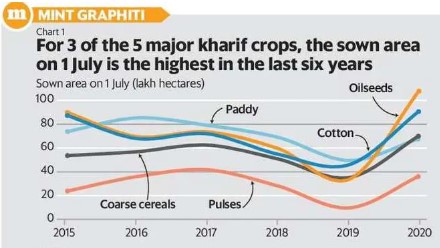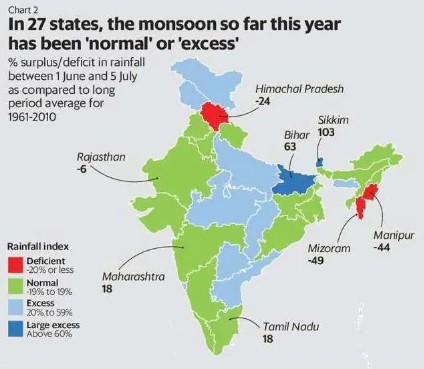Focus: GS-III Environment and Ecology, Prelims
Why in news?
India’s troubled agricultural sector, which employs about 60% of its workforce and contributes about 16% to its economic output, is set to record its best performance in recent years.

Why is the agriculture sector expected to perform well?
Monsoon Rains
- Substantial pre-monsoon showers in May 2020, followed by a timely onset of rains over the entire country, have spurred sowing across all major monsoon crops.
- Four of the five major monsoon crops saw an increase in the sowing area over their respective five-year average nationally.
- A combination of factors is behind the favourable farm conditions. Two cyclones, Amphan and Nisarga, struck on either coast in the pre-monsoon period. While they caused widespread destruction, they also brought significant rains to large swathes of India, paving way for early sowing of Kharif crops.
- Rains have been abundant and, more significantly, distributed well, and according to the India Meteorological Department (IMD), 27 states and union territories recorded ‘normal’ or ‘excess’ rainfall in July 2020.
- The kharif season (June to September) sees the sowing of crops such as paddy, millets, and especially pulses, oilseeds and cotton, which are predominantly rain-fed.

Reservoir capacity
- With reservoirs holding nearly twice as much water as last year, and a favourable monsoon forecast, it augurs well for enhanced agricultural productivity.
- Extreme monsoon caused severe floods in Kerala, Karnataka, Bihar and the North-East. However, this ensured the reservoirs were replenished.
- Reservoirs are crucial to irrigated kharif crops such as paddy, which require standing water.
COVID-19 Lockdown
- While most economic activity was at a standstill due to the covid-induced lockdown, farming was allowed to continue.
- With migrants returning from cities to their rural homes, additional hands in the farm may have also contributed to a greater labour pool.
-Source: Livemint



